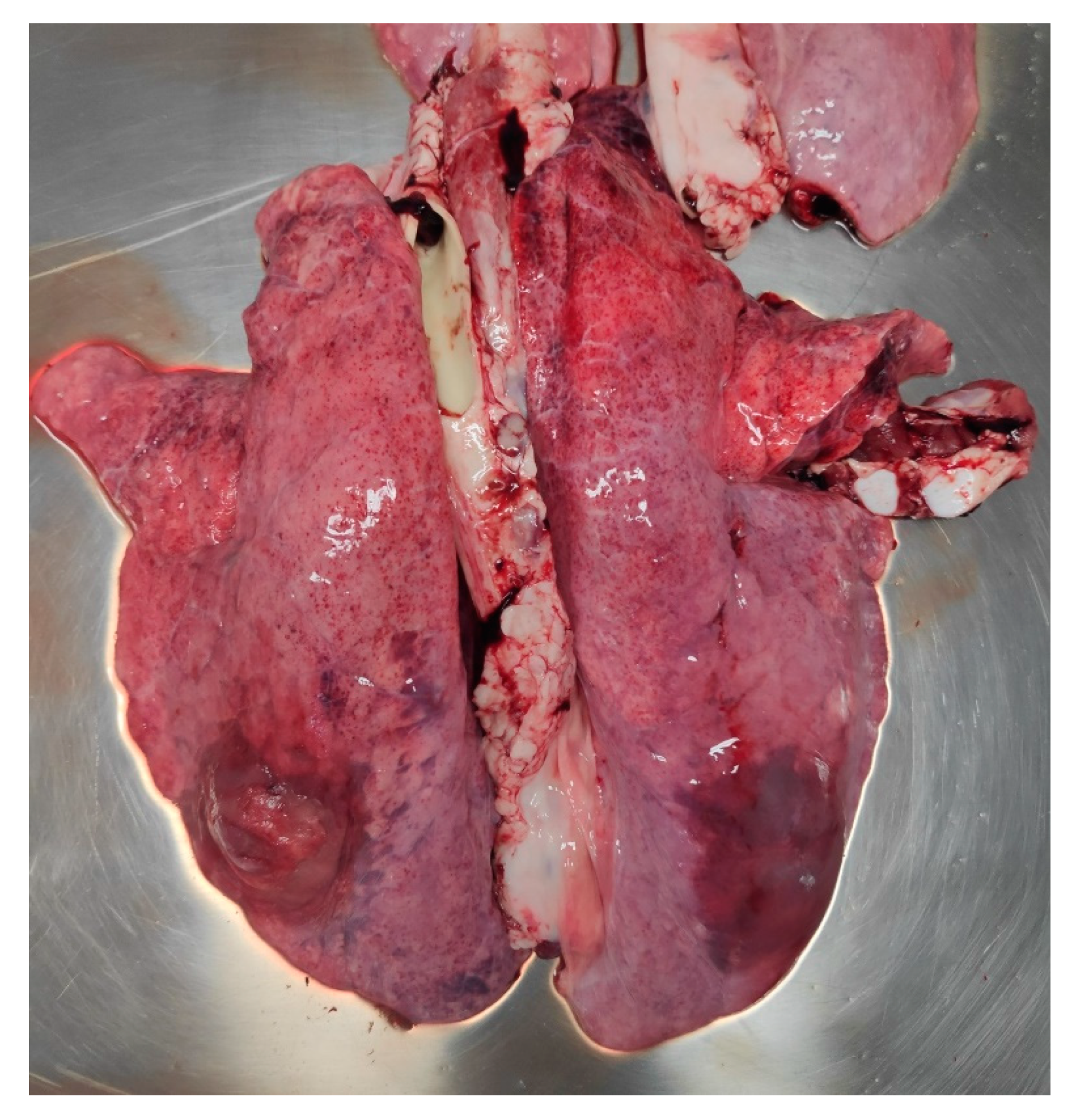Evaluation of the Efficacy of a Vaccination Program against Actinobacillus pleuropneumoniae Based on Lung-Scoring at Slaughter
Abstract
:Simple Summary
Abstract
1. Introduction
2. Materials and Methods
2.1. Farm History
2.2. Lung Scoring
3. Results and Discussion
4. Conclusions
Author Contributions
Funding
Institutional Review Board Statement
Acknowledgments
Conflicts of Interest
References
- Elicker, S.; Scherer, N.; Sipos, W. Retrospective analysis of the aetiology of respiratory disease in weaned piglets in Austria. Tierärztl. Umsch. 2009, 64, 484–489. [Google Scholar]
- Elicker, S.; Mayrhofer, E.; Scherer, N.; Fischer, L.; Weissenböck, H.; Sipos, W. Retrospective analysis of the aetiology of respiratory diseases of Austrian fattening pigs as well as gilts and sows. Wien. Tierarztl. Monat. 2009, 96, 246–252. [Google Scholar]
- Gottschalk, M.; Taylor, D.J. Actinobacillus pleuropneumoniae. In Diseases of Swine, 9th ed.; Straw, B.E., Zimmerman, J.J., D’Allaire, S., Taylor, D.J., Eds.; Blackwell Publishing: Ames, IA, USA, 2006; pp. 563–576. [Google Scholar]
- Cvjetković, V.; Sipos, S.; Szabo, I.; Sipos, W. Clinical efficacy of two vaccination strategies against Mycoplasma hyopneumoniae in a pig herd suffering from respiratory disease. Porc. Health Manag. 2018, 4, 19. [Google Scholar] [CrossRef]
- Madec, F.; Kobisch, M. Bilan lésionnel des poumons de porcs charcutiers à l‘abattoir. Journées Rech. Porc. Fr. 1982, 14, 405–412. [Google Scholar]
- Ostanello, F.; Dottori, M.; Gusmara, C.; Leotti, G.; Sala, V. Pneumonia disease assessment using a slaughterhouse lung-scoring method. J. Vet. Med. A 2007, 54, 70–75. [Google Scholar] [CrossRef] [PubMed]
- Dottori, M.; Nigrelli, A.D.; Bonilauri, P.; Merialdi, G.; Gozio, S.; Cominotti, F. Proposal for a new grading system for pleuritis at slaughterhouse. The S.P.E.S. (slaughterhouse Pleuritis evaluation system) grid. Large Anim. Rev. 2007, 13, 161–165. [Google Scholar]
- Merialdi, G.; Dottori, M.; Bonilauri, P.; Luppi, A.; Gozio, S.; Pozzi, P.; Spaggiari, B.; Martelli, P. Survey of pleuritis and pulmonary lesions in pigs at abattoir with a focus on the extent of the condition and herd risk factors. Vet. J. 2012, 193, 234–239. [Google Scholar] [CrossRef] [PubMed]
- Waehner, C.; Cvjetković, V.; Antonczyk, C.; Krejci, R. Survey of lung lesions of pigs at slaughter with the Ceva Lung Program in Germany and Austria. In Proceedings of the 12th European Symposium of Porcine Health Management, Bern, Switzerland, 14–16 April 2021; p. 516. [Google Scholar]
- Sipos, W.; Dobrokes, B.; Meppiel, L.; Sailer, J.; Friedmann, U.; Cvjetković, V. Association of lung score findings from slaughter pigs with their vaccination status against Mycoplasma hyopneumoniae and PCV2. Berl. Münch. Tierärztl. Wochenschr. 2020, 133, 1–5. [Google Scholar]
- Ruggeri, J.; Salogni, C.; Giovanni, S.; Vitale, N.; Boniotti, M.B.; Corradi, A.; Pozzi, P.; Pasquali, P.; Alborali, G.L. Association between infectious agents and lesions in post-weaned piglets and fattening heavy pigs with porcine respiratory disease complex (PRDC). Front. Vet. Sci. 2020, 7, 636. [Google Scholar] [CrossRef] [PubMed]
- Sipos, W.; Duvigneau, C.; Pietschmann, P.; Holler, K.; Hartl, R.; Wahl, K.; Steinborn, R.; Gemeiner, M.; Willheim, M.; Schmoll, F. Parameters of humoral and cellular immunity following vaccination of pigs with a European modified-live strain of porcine reproductive and respiratory syndrome virus (PRRSV). Viral Immunol. 2003, 16, 335–346. [Google Scholar] [CrossRef] [PubMed]
- Kekarainen, T.; Segalés, J. Porcine circovirus 2 immunology and viral evolution. Porc. Health Manag. 2015, 1, 17. [Google Scholar] [CrossRef] [PubMed] [Green Version]


| Parameter | October 2016 n = 68 | March 2017 n = 89 | July 2020 n = 30 | March 2021 n = 56 | August 2021 n = 60 |
|---|---|---|---|---|---|
| History | subacute/chronic disease | acute episode | vaccinated animals | acute episode | |
| Bronchopneumonia (%) | 69 | 63 | 43 | 11 | 5 |
| EP-index | 2.7 | 1.6 | 3.2 | 0.2 | 0.1 |
| Scars (%) | 22 | 40 | 10 | 0 | 0 |
| Cranial pleurisy (%) | 54 | 48 | 20 | 13 | 37 |
| Dorsocaudal pleurisy (%) | 50 | 60 | 43 | 5 | 30 |
| APP-index | 1.4 | 1.6 | 1.2 | 0.1 | 0.8 |
Publisher’s Note: MDPI stays neutral with regard to jurisdictional claims in published maps and institutional affiliations. |
© 2021 by the authors. Licensee MDPI, Basel, Switzerland. This article is an open access article distributed under the terms and conditions of the Creative Commons Attribution (CC BY) license (https://creativecommons.org/licenses/by/4.0/).
Share and Cite
Sipos, W.; Cvjetković, V.; Dobrokes, B.; Sipos, S. Evaluation of the Efficacy of a Vaccination Program against Actinobacillus pleuropneumoniae Based on Lung-Scoring at Slaughter. Animals 2021, 11, 2778. https://doi.org/10.3390/ani11102778
Sipos W, Cvjetković V, Dobrokes B, Sipos S. Evaluation of the Efficacy of a Vaccination Program against Actinobacillus pleuropneumoniae Based on Lung-Scoring at Slaughter. Animals. 2021; 11(10):2778. https://doi.org/10.3390/ani11102778
Chicago/Turabian StyleSipos, Wolfgang, Vojislav Cvjetković, Branimir Dobrokes, and Sabine Sipos. 2021. "Evaluation of the Efficacy of a Vaccination Program against Actinobacillus pleuropneumoniae Based on Lung-Scoring at Slaughter" Animals 11, no. 10: 2778. https://doi.org/10.3390/ani11102778
APA StyleSipos, W., Cvjetković, V., Dobrokes, B., & Sipos, S. (2021). Evaluation of the Efficacy of a Vaccination Program against Actinobacillus pleuropneumoniae Based on Lung-Scoring at Slaughter. Animals, 11(10), 2778. https://doi.org/10.3390/ani11102778






